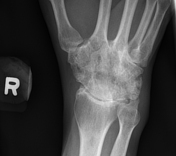Carpal coalition
Updates to Article Attributes
Carpal coalition refers to the abnormal union of two or more carpal bones, and is usually congenital, due to failure of separation of the involved bones during development. The The most commonly involved bones are the lunate and triquetrum, although many combinations of united bones have been reported.
Terminology
Carpal fusion is a misnomer, as it is the failure of normal segmentation of carpal mesenchyme that results in the anomaly 8. Carpal coalition is less contentious as its definition means a connection between two bones, it says nothing about how they came to be connected 9.
Epidemiology
The estimated prevalence is ~0.1% in Caucasian Americans and ~1.5% in African Americans, and and it tends to affect women more commonly 1,2.
Associations
There are several associated conditions, especially with multiple coalitions:
Pathology
As with tarsal coalition, congenital carpal coalition can either be osseous (synostosis), cartilaginous (synchondrosis), or fibrous (syndesmosis).
Aetiology
Non-syndromic congenital carpal coalition is transmitted via a Mendelian inheritance pattern. Acquired Acquired intercarpal fusion can either be a consequence of an inflammatory arthropathy (e.g.rheumatoid arthritis arthritis, psoriatic psoriatic arthritis, reactive reactive arthritis) or injury, or or due to intentional surgical arthrodesis.
Types
The two most common types of congenital carpal coalition are:
- lunotriquetral coalition: much more common than all other types combined
- capitohamate coalition
Less common
-<p><strong>C</strong><strong>arpal coalition</strong> refers to the abnormal union of two or more <a href="/articles/carpal-bones">carpal bones</a>, and is usually congenital, due to failure of separation of the involved bones during development. The most commonly involved bones are the <a href="/articles/lunate-1">lunate</a> and <a href="/articles/triquetrum">triquetrum</a>, although many combinations of united bones have been reported.</p><h4>Terminology</h4><p>Carpal fusion is a misnomer, as it is the failure of normal segmentation of carpal mesenchyme that results in the anomaly <sup>8</sup>. Carpal coalition is less contentious as its definition means a connection between two bones, it says nothing about how they came to be connected <sup>9</sup>.</p><h4>Epidemiology</h4><p>The estimated prevalence is ~0.1% in Caucasian Americans and ~1.5% in African Americans, and it tends to affect women more commonly <sup>1,2</sup>.</p><h5>Associations</h5><p>There are several associated conditions, especially with multiple coalitions:</p><ul>-<li><a href="/articles/ellis-van-creveld-syndrome">Ellis-van Creveld syndrome</a></li>-<li><a href="/articles/holt-oram-syndrome-3">Holt-Oram syndrome</a></li>-<li><a href="/articles/arthrogryposis">arthrogryposis</a></li>-<li><a href="/articles/turner-syndrome">Turner syndrome</a></li>-<li><a href="/articles/symphalangism">symphalangism</a></li>-</ul><h4>Pathology</h4><p>As with <a href="/articles/tarsal-coalition">tarsal coalition</a>, congenital carpal coalition can either be osseous (<a href="/articles/synostosis">synostosis</a>), cartilaginous (<a href="/articles/synchondrosis">synchondrosis</a>), or fibrous (<a href="/articles/syndesmosis">syndesmosis</a>).</p><h5>Aetiology</h5><p>Non-syndromic congenital carpal coalition is transmitted via a Mendelian inheritance pattern. Acquired intercarpal fusion can either be a consequence of an inflammatory arthropathy (e.g.<a href="/articles/rheumatoid-arthritis"> </a><a href="/articles/rheumatoid-arthritis">rheumatoid</a><a href="/articles/rheumatoid-arthritis"> arthritis</a>,<a href="/articles/psoriatic-arthritis"> psoriatic arthritis</a>,<a href="/articles/reactive-arthritis"> reactive arthritis</a>) or injury, or due to intentional surgical arthrodesis.</p><h5>Types</h5><p>The two most common types of congenital carpal coalition are:</p><ul>-<li>-<a href="/articles/lunotriquetral-coalition-2">lunotriquetral coalition</a>: much more common than all other types combined</li>-<li><a href="/articles/capitohamate-coalition-2">capitohamate coalition</a></li>-</ul><p>Less common</p><ul><li>-<a title="hamate-pisiform coalition" href="/articles/hamate-pisiform-coalition">hamate-pisiform coalition</a> <sup>10</sup>- +<p><strong>C</strong><strong>arpal coalition</strong> refers to the abnormal union of two or more <a href="/articles/carpal-bones">carpal bones</a>, and is usually congenital, due to failure of separation of the involved bones during development. The most commonly involved bones are the <a href="/articles/lunate-1">lunate</a> and <a href="/articles/triquetrum">triquetrum</a>, although many combinations of united bones have been reported.</p><h4>Terminology</h4><p>Carpal fusion is a misnomer, as it is the failure of normal segmentation of carpal mesenchyme that results in the anomaly <sup>8</sup>. Carpal coalition is less contentious as its definition means a connection between two bones, it says nothing about how they came to be connected <sup>9</sup>.</p><h4>Epidemiology</h4><p>The estimated prevalence is ~0.1% in Caucasian Americans and ~1.5% in African Americans, and it tends to affect women more commonly <sup>1,2</sup>.</p><h5>Associations</h5><p>There are several associated conditions, especially with multiple coalitions:</p><ul>
- +<li><a href="/articles/ellis-van-creveld-syndrome">Ellis-van Creveld syndrome</a></li>
- +<li><a href="/articles/holt-oram-syndrome-3">Holt-Oram syndrome</a></li>
- +<li><a href="/articles/arthrogryposis">arthrogryposis</a></li>
- +<li><a href="/articles/turner-syndrome">Turner syndrome</a></li>
- +<li><a href="/articles/symphalangism">symphalangism</a></li>
- +</ul><h4>Pathology</h4><p>As with <a href="/articles/tarsal-coalition">tarsal coalition</a>, congenital carpal coalition can either be osseous (<a href="/articles/synostosis">synostosis</a>), cartilaginous (<a href="/articles/synchondrosis">synchondrosis</a>), or fibrous (<a href="/articles/syndesmosis">syndesmosis</a>).</p><h5>Aetiology</h5><p>Non-syndromic congenital carpal coalition is transmitted via a Mendelian inheritance pattern. Acquired intercarpal fusion can either be a consequence of an inflammatory arthropathy (e.g.<a href="/articles/rheumatoid-arthritis"> </a><a href="/articles/rheumatoid-arthritis">rheumatoid</a><a href="/articles/rheumatoid-arthritis"> arthritis</a>,<a href="/articles/psoriatic-arthritis"> psoriatic arthritis</a>,<a href="/articles/reactive-arthritis"> reactive arthritis</a>) or injury, or due to intentional surgical arthrodesis.</p><h5>Types</h5><p>The two most common types of congenital carpal coalition are:</p><ul>
- +<li>
- +<a href="/articles/lunotriquetral-coalition-2">lunotriquetral coalition</a>: much more common than all other types combined</li>
- +<li><a href="/articles/capitohamate-coalition-2">capitohamate coalition</a></li>
- +</ul><p>Less common</p><ul><li>
- +<a title="hamate-pisiform coalition" href="/articles/hamate-pisiform-coalition">hamate-pisiform coalition</a> <sup>10</sup>
Image 11 X-ray (Frontal - Ulnar Deviation) ( create )







 Unable to process the form. Check for errors and try again.
Unable to process the form. Check for errors and try again.